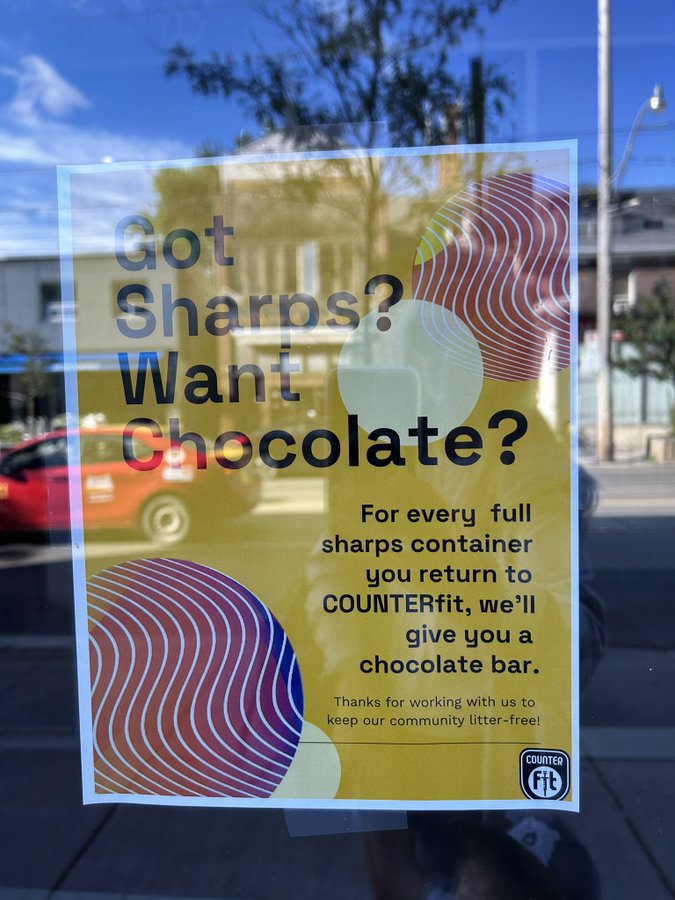Addiction Compassion, Community Safety Disinterest
"Used needles also started popping up in the rear lanes on both sides of Heward Avenue, my street. These lanes are playgrounds for the many children who live on these streets, relatively traffic-free spaces where they can ride their bikes, play catch and shoot at basketball and hockey nets.""By 2019 there was a distinctive shift outside the South Riverdale Community Health Centre. It had, in a short amount of time, been transformed from a place of semi-discreet open use to something that bore a much closer resemblance to the open-air drug emporium that would grow over the next four years.""Drug dealing was becoming more rampant, as was open use.""Drug dealers would arrive by car across from my house most mornings, and the buyers would not-so-discreetly arrive to make purchases. There were also suddenly dealers on foot. But the most common dealers, especially of late, are ones on bikes, typically wearing backpacks."Derek Finkle, Leslieville, Toronto
 |
| A view of the South Riverdale Community Health Centre. (CBC) |
This
is a description of a 'supervised consumption' site. Where the
drug-addicted receive special care in an effort to keep them from being
yet another statistic of a fatal overdose scenario. Fentanyl use is
raging across Canada. Toronto isn't the worst Canadian city for drug
overdoses, Vancouver takes that very special award. In fact, Vancouver
is likely the most overdose-prone city in all of North America. The
struggle by compassionate health authorities to keep people alive is
commendable.
The
people who live adjacent to supervised consumption sites may not
consider their proximity to be much of a boon to the quality of their
lives and that of their children, however. The sites are notorious for
public disorder and crime; the centres' managers seem incapable of
addressing these inconvenient side-issues that turn ordinary citizens'
lives inside-out and upside-down. The commitment of the drug centres is
to the addicted, not to people living in close proximity to their
life-saving facilities.
Some
of these centres hire active drug users and dealers for the success of
their programming; people who have the 'lived' experiences, since who
else knows as much about addiction as they do? And who would be more
sympathetic to the plight of the addicted? And less affected by the
crime scenarios that abound? As for example when an area resident was
killed by a stray bullet near the safe injection site in the Leslieville
community in July.
 |
If you live in Leslieville and you're concerned about your kids picking up needles that surround the drug consumption site, you don't have to worry. In fact, if your kids collect enough they can trade them in for chocolate! Ginnie Roth |
A
harm reduction worker at the South Riverdale Community Health Centre,
Khalila Zaa Mohammed, was arrested a month later, charged for assisting
one of the shooting suspects to escape and hide from authorities. In the
wake of her arrest a "critical incident review"
was initiated of Ontario's consumption sites beginning with the SRCHC.
The safe injection site sits within 100 metres of two schools and three
daycares where used needles are ubiquitous, and a 5-year-old boy found a
baggie with a chunk of orange fentanyl.
The South Riverdale Community Health Centre has initiated "Harm Reduction Satellite Sites"
and there drug users are paid to operate quasi-supervised consumption
sites right out of their own homes. A partner organization had an
operating guide published for the edification of other service providers
who might want to launch similar programs. The guiding principles of
the document include building "spaces and services where repressive drug laws cannot be enforced". Service providers are encouraged to hire drug dealers to run the sites.
Trafficking is viewed as a type of expertise, and cooperation with dealers "a great way to reach people who otherwise don't typically engage with harm reduction services". Going to jail is a "part of life", the guide asserts; and satellite workers should remain on the payroll while incarcerated. It is "not appropriate to expect sobriety" from contracted drug users or dealers even while providing harm reduction services; "expectations
that workers not use drugs with clients, which might be standard in
other programs, should not apply to satellite workers".
The
sites' existence should be hidden from landlords and other tenants to
avoid eviction, service providers and satellite workers are advised by
the guide that argues satellite workers can help users with information
about police activity since they're within distressed communities.
Citing journalist and Leslieville resident Derek Finkle, neighbours
witness harm reduction workers using drugs outside the main consumption
site of SRCHC, where police are "disinvited" from the property.
The
situation prevails right across the country with Canadians reporting
similar experiences at other consumption sites -- public drug use and
trafficking, along with a crime epidemic and violent harassment. With it
all a complete disinterest in how local residents are faring in this
maelstrom of drugs, crime and flouting of the criminal justice system.
 |
Labels: Community Safety, Criminal Activities, Harm Reduction, Illegal Drugs, Safe Consumption Sites, Toronto

<< Home